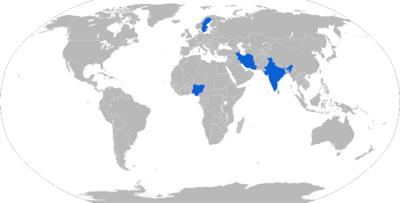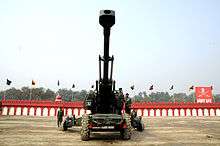Haubits FH77
| Haubits FH77/A | |
|---|---|
|
The Haubits FH77/A | |
| Type | Howitzer |
| Place of origin | Sweden |
| Service history | |
| In service | 1978 – present |
| Used by |
Swedish Army Indian Army |
| Production history | |
| Designer | Bofors |
| Designed | 1978 |
| Manufacturer | Bofors |
| Unit cost | $3,900,000 (1986)[1] |
| Produced | 1978–1984 |
| No. built | 720[2] |
| Variants | See Variants |
| Specifications | |
| Weight | 11,500 kg (25,400 lb) |
| Length | Combat: 11.60 m (38 ft 1 in) |
| Barrel length | 5.89 m (19 ft 4 in) L/38 |
| Width | Combat: 9.73 m (31 ft 11 in) |
| Crew | 9 to 14 |
|
| |
| Shell | 155 mm NATO |
| Caliber | 155 mm |
| Action | semi-fixed ammunition, propellant charge is contained in a plastic cartridge case with a steel head |
| Breech | Vertically sliding breech block, hydraulic ramming |
| Carriage | split trail with castor wheels |
| Elevation | -5°/+70° |
| Traverse | 30° left or right from centreline |
| Rate of fire |
4 rounds in 9 seconds, 6 rounds in 25 seconds, sustained 3 rpm for 20 minutes |
| Muzzle velocity | 300 to 770 m/s (980 to 2,530 ft/s) |
| Effective firing range | 21 km (13 mi) |
| Maximum firing range | 24 km (15 mi) (with base bleed-round) |
| Feed system | hydraulically powered flick rammer assisted loading |
|
| |
| Engine | Volvo B20 APU |
| Speed | 6 km/h |
Fälthaubits 77 (Swedish "Field Howitzer 77") or FH77 is a Swedish 155 mm howitzer. It was developed and manufactured by Bofors. It was available in two versions, the original (sometimes referred to as Haubits 77 A) with a 38 calibre barrel and sliding block mechanism, and the later FH77 B export version with a 39 calibre barrel and an interrupted screw breech.
Design and development
Overview
In the 1960s, Sweden started to look for a replacement for the French Haubits F (Obusier de 155 mm Modèle 50). The American M109 howitzer was offered and tested. Though the price was low, the Swedish Arms Administration found that the high maintenance costs, the low rate of fire and the limited mobility of the M109 made it worth the effort to develop a domestic howitzer.
The requirements for a new gun would be:
- High mobility.
- High momentary rate of fire.
The result was a compromise between a more expensive self-propelled howitzer and a less mobile conventional towed howitzer.
The FH77 was the first field howitzer featuring an APU to make it self-propelled for tactical movement.
The rate of fire was, at the time, exceptionally high for a 155 mm howitzer. The FH77A (which uses semi-fixed ammunition) could fire 4 rounds in 9 seconds, or 6 rounds in 25 seconds. In a sustained firing role, it could fire 6 rounds every two minutes for 20 minutes (i.e. 3 rounds per minute).
In order to use standard NATO ammunition, the FH77B was developed. While the sliding-block worked well with the cased charges acting as a seal, it was decided that bagged charges required an interrupted screw breech. This, combined with the slightly longer barrel, resulted in a slightly improved range but also a lower rate of fire. At the same time, the petrol-fueled APU was exchanged with a diesel-fueled one, allowing it to use the same fuel as the towing vehicle.
Driving and deploying
The dedicated towing vehicle for the FH77 was the Scania SBA111 (Tgb 40). The truck was equipped with a crew compartment behind the driving cab and a HIAB-crane for ammunition handling. The Howitzer's APU can be started and controlled by the driver of the towing vehicle to give an extra boost during off-road driving. The maximum towing speed is 70 km/h (45 mph).
The FH77 is manoeuvred by the gun layer, controlling the torque of the two main wheels through a joystick. Speed is regulated by changing the APU's RPM. The howitzer is deployed by spreading the trail legs, raising the castor wheels and driving the howitzer in reverse to anchor the recoil spades.
APU
The FH77 is powered by a Volvo B20 Auxiliary power unit (APU), which gives the gun a top speed of 7 km/h. The engine is connected to three hydraulic pumps, of which two are linked to the wheels and one is used for a traverse, elevation, ramming and ammunition crane. The fuel tank could hold 40 litres, with two extra 20L jerry-cans as a reserve in front of the gun layer's position.
Crew
The crew consists of 10–14 men. The minimum crew setup would be 4 men; commander, gun layer, loader 1 and loader 2.
- The commander directs all the activity of the crew from a platform to the left of the gun layer.
- The layer sits on the left hand side of the gun, operating the fire control computer and driving the howitzer when in self-deployment mode.
- Loader 1 is located to the right hand side of the gun and is in charge of supplying the shells from the loading table in front of him.
- Loader 2 and 3 would be working on the ground, providing shells to loader 1 by means of a hydraulic crane and loading cases in the loading trough.
- Loader 3 is normally the driver of the towing vehicle.
Ammunition
The FH77A uses the m/77 (42 kg) 155mm HE shell combined with a plastic casing, containing six increments.
The FH77B uses standard NATO 155mm ammunition with bagged drive charges.
Both are able to use base bleed ammunition developed for the FH77B, as well as Bofors 155 Bonus and M982 Excalibur.
Controversy in India
The Bofors scandal was a major political scandal that occurred between Sweden and India during 1980s and 1990s, initiated by Congress politicians and implicating the Indian prime minister, Rajiv Gandhi, and several other members of the Swedish and Indian governments, who were accused of receiving kickbacks from Bofors AB for winning a bid to supply India's 155 mm field howitzer.[3]
This resulted in India not exercising the option for 48 additional FH77B, instead these guns were acquired by the Swedish army and have now been converted into the Archer Artillery System.
Variants
Towed variant
- FH77 A – original baseline version with the Volvo B20A petrol-engine and 38 calibre barrel.
- FH77 B – export version with a Mercedes om-616 918 diesel-engine, 39 calibre barrel and lower rate of fire as a result of a modified breech block to use NATO compatible ammunition.
Vehicle-mounted variant
- Archer Artillery System – self-propelled FH77B-version with a 52 calibre gun mounted on the chassis of a Volvo articulated hauler.
Operators


Current operators




References
Notes
- ↑ http://armstrade.sipri.org/armstrade/page/trade_register.php
- 1 2 3 Mats Persson. "Swedish 155mm Field Howitzers". Archived from the original on 27 February 2005. Retrieved 10 July 2009.
- ↑ "What the Bofors scandal is all about". IBN Live. Archived from the original on 16 September 2012.
- ↑ "Arms trade register". SIPRI. Retrieved 21 February 2013.
- ↑ "Artillery Booms Again". South Asia Defence & Strategic Review. Retrieved 21 February 2013.
- ↑ "Murky Competitions for Indian Howitzer Orders May End Soon". Retrieved 2013-02-21.
- ↑ Ritu Sharma. "Higher calibre artillery gun to be ready by 2013:MoD". Retrieved 16 May 2012.
- ↑ http://indianexpress.com/article/india/india-others/army-to-soon-induct-indigenous-artillery-gun-dhanush-a-k-a-desi-bofors
- ↑ "Fanning the Flames: Guns, Greed & Geopolitics in the Gulf War". Retrieved 12/01/2013. Check date values in:
|accessdate=(help)
Bibliography
Instruktionsbok 15,5 cm Haub 77A Försvarsmakten, 2000, M7786-004750
Instruktionsbok 15,5 cm Haub 77B Försvarsmakten, 1995, M7786-007870
External links
| Wikimedia Commons has media related to Field Howitzer 77. |